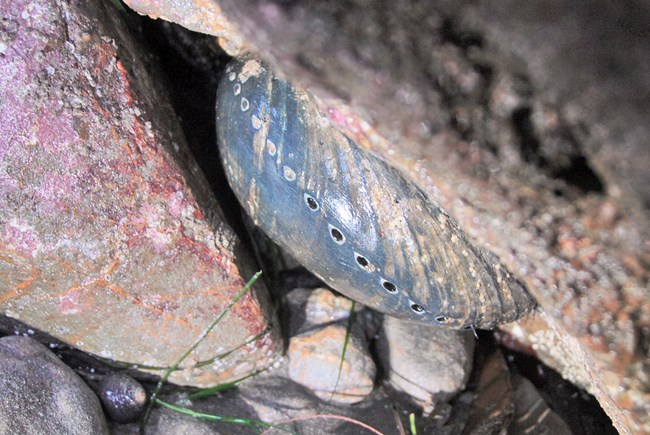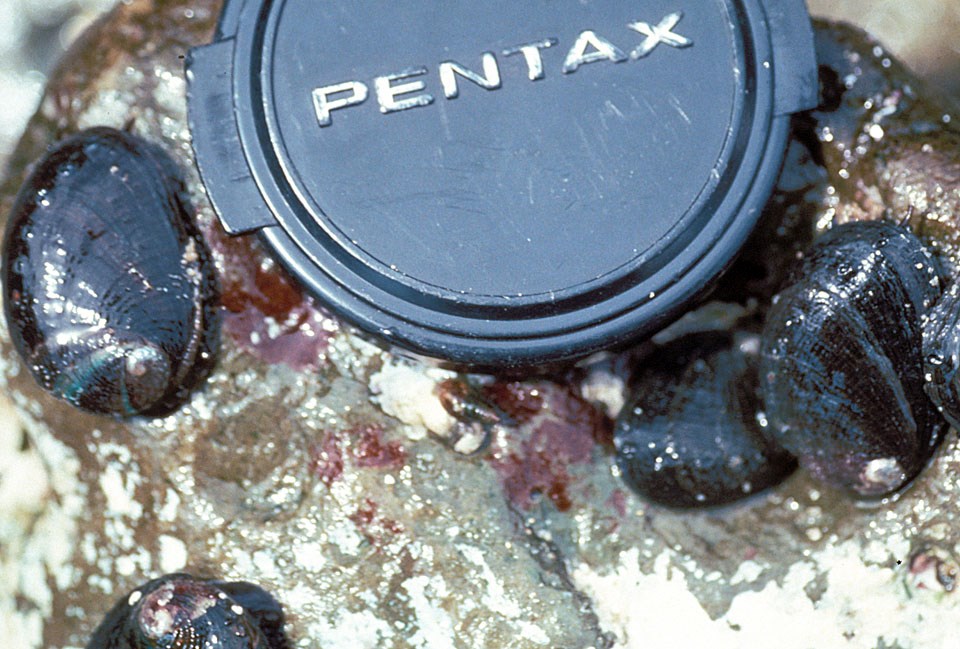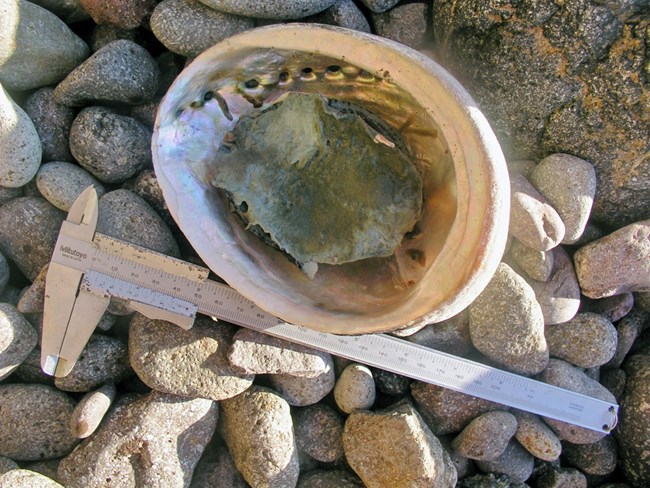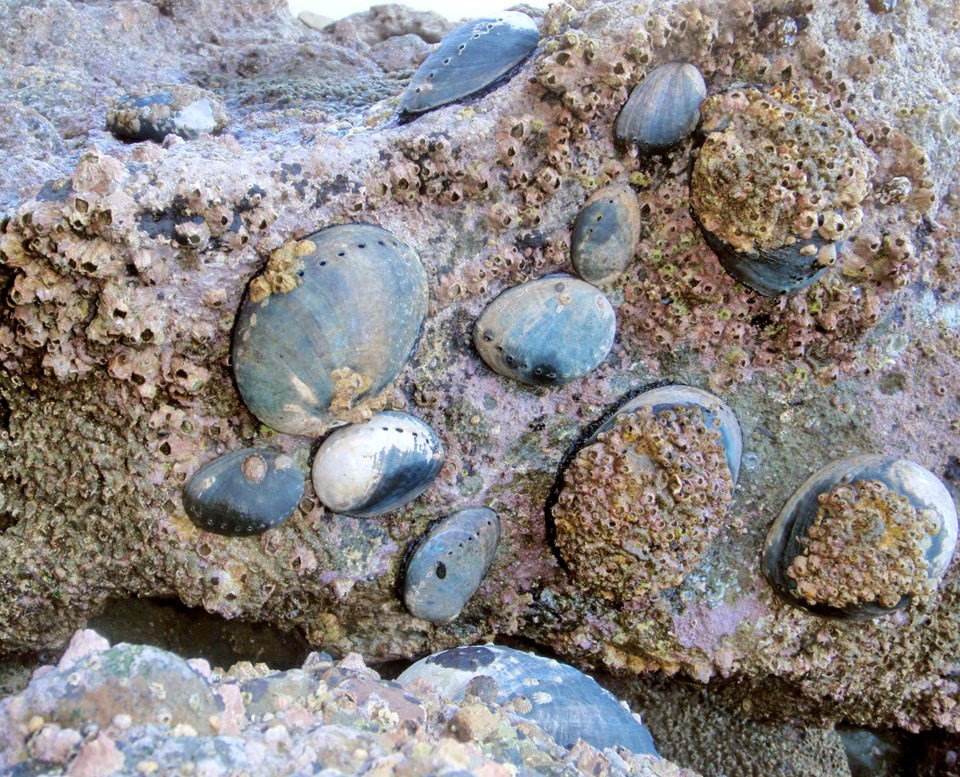Last updated: March 21, 2017
Article
Black Abalone Regain Lost Ground

NPS / Jessica Weinberg McClosky
March 15, 2017 - For nearly 20 years, Channel Islands National Park biologists recorded the same number of black abalone (Haliotis cracherodii) at Cuyler Harbor: zero. Modern abalone monitoring began at Cuyler Harbor, located on San Miguel Island, in 1992. At that time, biologists counted 165 of the dark, smooth-shelled sea snails. After 1997, they found none. The black abalone had fallen victim to withering syndrome, a disease that may have been exacerbated by the warm-water El Niño events of the 1990s. Black abalone throughout the region suffered a similar fate. By 1998 less than one percent of southern California's historic black abalone population remained.
Fortunately, at Otter Harbor, just a few miles away on San Miguel Island, a depleted population of survivors persisted. In parts of the rocky intertidal zone that were once covered in layers of abalone five individuals deep, fewer than a hundred individuals remained. Small remnant populations hung on in other places as well, but mostly at sites on San Miguel. The survivors were typically older, larger abalone, and for several years, that was almost all biologists could find. There was little evidence of a successful younger generation, which didn’t bode well for the future.
Otter Harbor, San Miguel Island


Left image
View of Otter Harbor in 1986.
Credit: NPS
Right image
View of Otter Harbor in 2008.
Credit: NPS
Then, beginning around 2007, more young black abalone began turning up, mostly on Santa Cruz Island. At first, the sight of so many juveniles was strange and unfamiliar. The youngest abalone recruits, at less than an inch long, appeared miniature alongside some of their older, cereal bowl-sized counterparts.

NPS
One particular site on the south side exemplified the trends on Santa Cruz Island. Where counts were once down to one, abalone numbers began climbing exponentially. Within a few years, the population numbered in the hundreds. Other sites across the islands also began seeing growing numbers of black abalone.
Black Abalone Counts at Channel Islands National Park, 1985-2014


NPS
Although populations were on the rise, withering syndrome did not disappear. Diseased individuals and empty abalone shells have continued to turn up over the years. A dip in abalone numbers on some islands from 2013 to 2015 could be related to a resurgence of the disease.
San Miguel Island sites were the last to see a rise in juvenile abalone. Aside from a brief surge in 2005, juveniles remained rare there until last year. Now though, Otter Harbor abalone are looking younger than ever. A growing number of new recruits seem to be appearing among the older abalone. But what of Cuyler Harbor?
As changes in the abalone population played out throughout the park, abalone remained absent from Cuyler Harbor. That is, until 2016. After almost two decades of fruitless searches, biologists discovered a single adult black abalone! This year, however, their surprise was even greater. Where they would have been excited to find one or two, biologists counted 15 black abalone!

NPS
Part of the surprise for biologists at Cuyler Harbor is that they don't really know how the abalone got there. The site is small, with hardly any crevasses hidden from human eyes, so they doubt they missed any young abalone in recent searches. Yet most of the abalone were already several years old. Did they climb over the impressive ridge separating the site from good habitat to the East? Did they navigate a sandy subtidal area to get around the ridge? Biologists had not previously pictured the humble black abalone achieving such feats.
The other thrilling part of the Cuyler Harbor discovery is the sheer amount of time that had passed between abalone sightings. The ability to document such a cycle of disaster and potential recovery over the course of decades is a testament to the value of long-term monitoring efforts. As more decades of data accumulate, our understanding of the normal variability of nature grows. Over time we also become better able to detect when something unusual or concerning is taking place. For example, monitoring results showing a sharp population crash helped justify protecting the black abalone under the Endangered Species Act in 2009.

NPS
Now, biologists are hoping to continue learning about what a black abalone recovery looks like. As they do, they may be able to come up with measurable ways of describing a healthy population. One measure, for instance, could be the population’s percentage of juvenile abalone. If all goes well, such metrics could one day be used to justify delisting the black abalone as an endangered species.
Prepared by the Mediterranean Coast Inventory and Monitoring Network.
